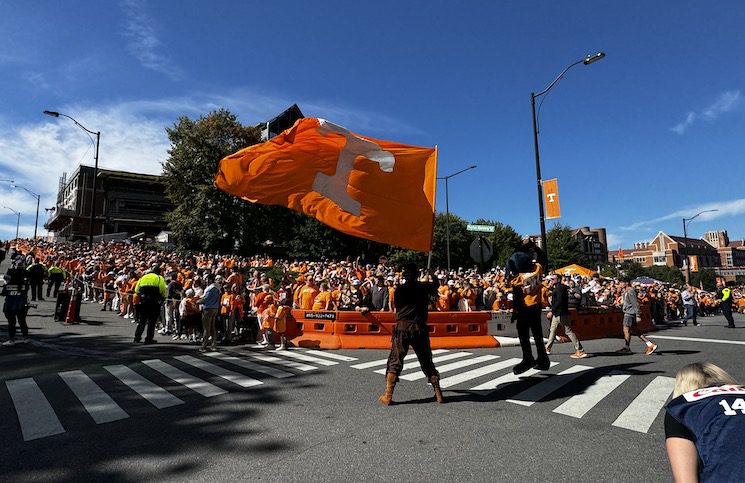Our “Blueprint” feature takes a deeper look at UT’s upcoming matchup, and focuses on what UT needs to do to win the game. It’s not necessarily indicative of how we expect the game to go.
When Appalachian State is on Offense: Appalachian State’s offense finished first in the Sun Belt last season and 26th in the NCAA (467.3 ypg), while Tennessee finished 52nd overall (422.3 ypg). The Mountaineers finished 11-2 (2nd in Sun Belt) with a 31-29 victory over Ohio in the Camellia Bowl in 2015.
Bob Shoop’s first test as Tennessee’s defensive coordinator will be to stop the Mountaineers on offense.
Appalachian State returns a good number of upperclassmen on both sides of the ball, but especially on offense. Junior quarterback Taylor Lamb is talented. As a sophomore last year, he threw for 2,387 yards, 31 touchdowns and just nine picks. He finished 10th nationally with a 160.7 pass-efficiency rating. Not only can Lamb beat teams through the air, he can beat them with his legs (436 rushing yards, 5 touchdowns).
The Mountaineers also return senior running back Marcus Cox (1,432 yds), who rushed for 162 yards in a Camellia Bowl MVP performance. Cox ranked 13th nationally in rushing yards per game at 118.6. He has surpassed the 1,000-yard mark the past three seasons, and he looks to do the same this year. The Mountaineers’ rushing attack also returns Jalin Moore (731 yds) and Terrence Upshaw (442 yds).
Appalachian State does have holes at receiver with Bobo Beatherd, Malachi Jones, and Simms McElfresh all gone, but junior Shaedon Meadors should be one of the Sun Belt’s top performers. Meadors only had 21 catches last season, but he made them count – averaging over 20 yards per reception.
Head coach Scott Satterfield has implemented a spread offense that is similar to what Tennessee runs. The run game usually comes first, but they like to throw short slants, hitches, and bubbles to open up the deep threat. The quarterback needs to be mobile in this system and Lamb, who has over 900 yards rushing in his two years at App. State, fits the bill.
For a majority of the 2015 season, the Mountaineers ran out of the pistol, which allows for a quick rush or pass attack when needed. Appalachian State likes to use the pistol because it allows the quarterback to be close enough the line of scrimmage to be able to read the defense, as with run situation sets such as the I-formation. It also allows the quarterback to be far back enough to give him extra time in the pocket and give him better field vision for passing plays, as in the shotgun. In addition, the offensive line will pull and be mobile in this system.
The Mountaineers utilize a lot of play action, which could pose a problem for the defense. They will run the ball as much as they need to in order to gain the defense’s respect. They can also lull teams to sleep in the short passing game.
 Shoop has already mentioned how aggressive he likes to be. He loves to bring the pressure on blitzes. He likes to run a 4-2-5 defensive set, which also includes a nickelback (Foreman or Gaulden) used for coverage or edge blitzes. The use of three base coverages with a two-deep safety alignment is designed to keep the ball out of the end zone.
Shoop has already mentioned how aggressive he likes to be. He loves to bring the pressure on blitzes. He likes to run a 4-2-5 defensive set, which also includes a nickelback (Foreman or Gaulden) used for coverage or edge blitzes. The use of three base coverages with a two-deep safety alignment is designed to keep the ball out of the end zone.
Shoop can have success by keeping everything simple in the playbook. His entire defense can just be made up of blitzes and three base coverages such as Cover 2 Robber, Cover Blue, and Cover 5 for examples. In these coverages, the safeties (Todd Kelly, Micah Abernathy, Nigel Warrior, Evan Berry) will have an active role in run support, which means they are good and rangy tacklers. The cornerbacks will have to hold their own on the outside. However, the safeties look at the receivers for their reads, not the offensive line. This will make them less vulnerable to the play action Appalachian State likes to run. Early on, the safeties can lurk around the line of scrimmage, which can be good for blitzing or showing fakes, which is the kind of mixture Shoop wants. The use of stunts, twists, and wide alignments by the defensive ends can disrupt the offensive line’s pulls up field. This will also create a lot of confusion for the entire Mountaineer offense.
Tennessee’s defense should have the upper hand as they are more talented and explosive than Appalachian State’s offensive line can handle all game. Derek Barnett and Corey Vereen can play the edge as well as anyone in the country, and if you mix that in with the powerful tackles (O’Brien, McKenzie, Tuttle, Vickers) then the offensive line will not be able to last.
If Lamb wants to throw the short pass or dump off (which he will), then the receiver or running back will be forced to run more horizontal than vertical, which will allow the linebackers and secondary to push down for help before he gains too much yardage. If Shoop can maintain exotic looks and a constant defensive rush throughout the game, then the Mountaineers will be handcuffed on offense.
When Appalachian State in on Defense:
The Mountaineers finished 11th nationally in total defense last year, allowing an average of 314.5 yards per game. They gave up an average of 4.7 yards per play. Those are some solid numbers for a first year FBS program. The Mountaineers, however, lost their star defensive end and NFL prospect Ronald Blair. Linebackers Eric Boggs (team-high 104 tackles) and John Law (72 tackles, 9.5 TFL) both return, as does cornerback Latrell Gibbs, who is coming off a seven-interception season.
Fourth year defensive coordinator Nate Woody likes to utilize a 3-4 scheme, but can also switch to multiple if need be. Woody’s 3-4 defense allows for flexibility, especially for the linebackers. Like Shoop, Woody wants to create pressure for the quarterback. Depending on the situation, any number of linebackers can blitz, fake a blitz, spy the quarterback/running back, or play in coverage. Look for Appalachian State to run various zone blitzes, which allows one linebacker to play in coverage opposite of the blitzing one. The two inside linebackers will have the task of focusing on the run.
Mike DeBord has more than enough offensive weapons at his disposal to throw off the Mountaineers’ defense. It’s almost guaranteed they will regularly place a spy on Josh Dobbs, so DeBord will need to play it smart in terms of designed quarterback draws and read options. The good thing about Tennessee’s rushing attack is that DeBord can mix in a combination of a power and elusive run game thanks to Jalen Hurd and Alvin Kamara.
The rushing attack will also receive help from a seasoned offensive line. DeBord likes quick and effective linemen that can pull and push up field. With the offensive line’s help, Hurd and Kamara must get a good amount of touches, along with draws and play action from Dobbs to keep those linebackers guessing. DeBord very well could draw up some plays from the pistol with Dobbs, Hurd and Kamara in the backfield. This type of formation will have Appalachian State on edge, because if the Mountaineers send the wrong blitz or spy the wrong player, then Tennessee’s offense could burn them badly.
Once the Vols can get the run game going from various players, then DeBord should be able to open up the passing game. Similar to Appalachian State, Tennessee also likes to run short routes and play action to open up the deep threat. If Dobbs can execute well on the short plays and sell the play action, then look for players like Josh Malone and Preston Williams to become the deep targets. Tennessee’s up-tempo spread offense posed many problems for every team last year, including Alabama. The Vols can offer multiple looks and sell the play action very well. If Woody shows DeBord a unique look on defense, then he needs to throw one back at him on offense.
Even though Appalachian State has a talented defense, the Vols should be able to move the ball consistently and often. There are too many offensive weapons for the Mountaineers to defend all game. The Mountaineer defense might give Tennessee some trouble early on, but don’t expect them to hold out.




